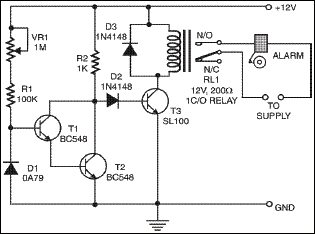This temperature switch has high sensitivity and is quite reliable. Here, in place of a single transistor, a Darlington pair has been used for switching.

At normal room temperature germanium diode D1 (0A79 or equivalent) has a back resistance value of about 10 kiloohms. As a result, the Darlington pair comprises transistors T1 and T2. conducts and keeps the anode terminal of diode D2 at ground potential. Consequently, transistor T3 does not get base bias and thus relay RL1 is not activated.
But when temperature increases sharply, which results in the cutting off of the Darlington pair and forward biasing of transistor T3 via resistor R2 and diode D2. As a result, relay RL1 energizes and switches on the alarm. Potmeter VR1 may be adjusted for required sensitivity.
This simple circuit can be used as an overheat indicator, or fire alarm, or it can be used in a constant temperature circuit for switching on a fan, etc. The circuit can be easily assembled on a piece of veroboard. Diode sensor D1 must be of germanium type and not silicon.





